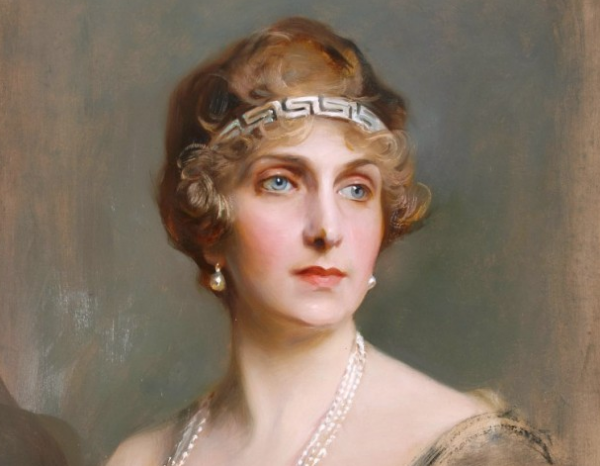 |
| Detail of a portrait of Queen Ena of Spain, ca. 1920s (Wikimedia Commons) |
London, August 14 — London and Paris share one distinction: they are the only capitals in Europe to which reigning sovereigns pay private visits. Even in the pre-war days foreign sovereigns never went privately to Berlin, Vienna or Petrograd, and put up at an hotel as the King and Queen of Spain are doing at Claridge’s [1].
The visit of the King and Queen of Spain [2] has added brilliance to the moment when the season bat son plein, and to the wonder and marvel of a great many people their majesties gave a luncheon party in the restaurant at Claridge’s.
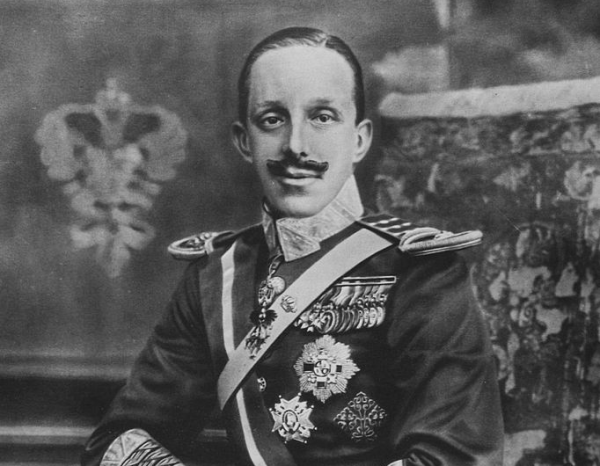 |
| King Alfonso XIII of Spain (Wikimedia Commons) |
Why people should be surprised, I don’t know. The visit is a private one, and when royalty is not paying a state visit it has the privileges of the ordinary visitor. On former visits when they stayed at the Ritz, King Alfonso and Queen Ena frequently lunched in the restaurant, and when she has come over alone, Queen Ena has on more than one occasion done the same thing.
It seems very hard in these democratic days that just because you are a king or a queen you must eat all your meals in a private dining-room when you are paying an official visit to a foreign capital. Yet some people are filled with surprise over that little lunch party and the royal taking of coffee afterwards in the lounge.
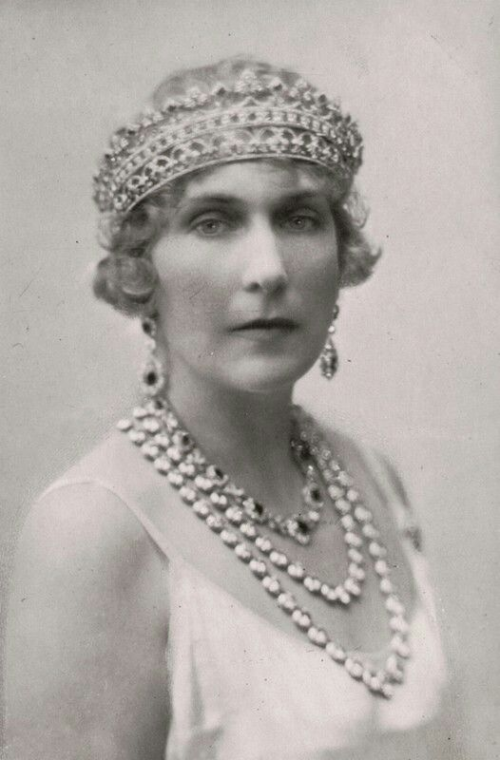 |
| Queen Ena wearing the Strawberry Leaf Tiara bequeathed by Queen Victoria to Ena’s mother, Princess Beatrice; read more over here! |
The dinner given by Marques and Marquesa Merry del Val [3] at the Spanish Embassy for their Spanish majesties was one of those entertainments that set the words “pomp and circumstance” running through your head. Queen Ena’s dress and jewels were wonderful.
And the old custom for the reception of a King and Queen of Spain was followed. Footmen in state liveries stood in a double line across the hall from the front door to the staircase, each one holding a lighted candle in his right hand.
The history of the Spanish monarchy is, in a measure, the counterpart of the history of our monarchy. In both countries a woman has saved the dynasty.
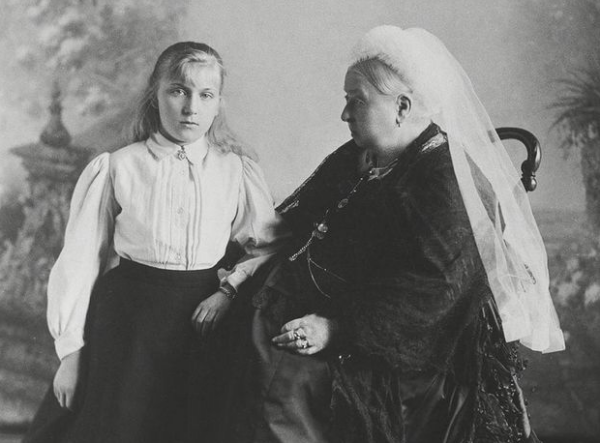 |
| Queen Ena of Spain with her grandmother, Queen Victoria of the United Kingdom |
You have only to go to your history books to know what would have happened in this country if the Duke of Cumberland [4] had succeeded William IV [5] instead of the little Princess Victoria [6]. The Duke of Cumberland was so hated and detested that he wouldn’t have reigned very long. His niece pulled the monarchy out of the mire into which George IV and some of his brothers had plunged it, and made it so integral a part of our national life that we all know the country couldn’t exist without it. King Edward [7] and King George [8], by their devotion to their office, have built upon the solid foundation laid by Queen Victoria.
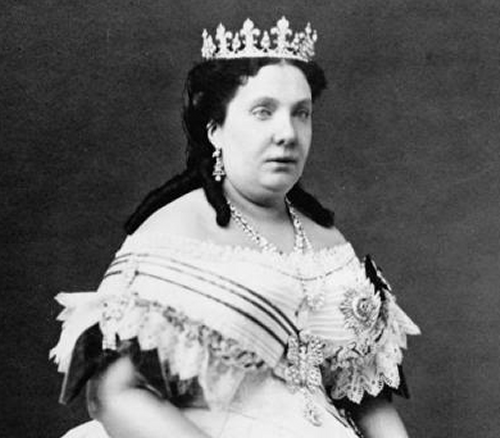 |
| Queen Isabella II of Spain (Wikimedia Commons) |
That’s the English story. In Spain the situation was more difficult. King Alfonso’s father, Alfonso XII [9], had succeeded his dethroned mother, Queen Isabella [10], who had been driven out of Spain by a revolution. I can’t tell you Queen Isabella’s story here except to say that her marriage to Don Francois d’Assisi [11], arranged by King Louis Philippe of France [12], was one of the most calculating and wicked manouvres ever wrought in la haute politique. At the same time Queen Isabella’s sister [13] was married to Louis Philippe’s son, the Duc de Montpensier [14], in the belief that the Queen would have no children, and that the Spanish crown would go to the Duchesse de Montpensier, and that Spain, therefore, would come under the domination of France. It was a devilish plot, and you will find all the details under “the Spanish Marriages” in the history books, and Queen Victoria’s very outspoken opinion in her letters.
Well, the plot didn’t succeed, because Queen Isabella had children. Nobody could blame the Spaniards for rising up against her and forcing her to leave the country, as they did in 1868. She brought the trouble entirely on herself. Six years afterwards, after goodness knows what internal troubles, the Spaniards chose her eldest son as their king. This was Alfonso XII.
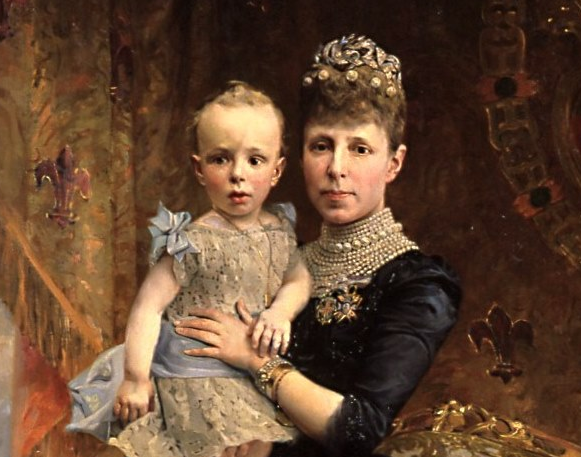 |
| Queen Maria Cristina of Spain with her son, King Alfonso XIII of Spain (Wikimedia Commons) |
His first wife died childless. Then he married the Archduchess Maria Christina of Austria [15]. He died six years later, leaving two daughters. The elder, the Infanta Mercedes, was proclaimed Queen of Spain [16] under the regency of her mother. Six months later a son was born to the widowed Queen Maria Christina, the present King Alfonso, and the sister had to give way to the brother.
NOTES
1. Claridge’s Hotel in London has long had a reputation as a home away from home for royals. The hotel was founded in 1812, and it cemented its royal reputation when Empress Eugenie of France stayed there in 1860. One royal, Crown Prince Alexander of Yugoslavia, was even born in Claridge’s while his parents, King Peter II and Queen Alexandra, were in exile during World War II. Suite 212 was ceded to Yugoslavia for one day to allow the crown prince to be born on Yugoslavian territory.
2. King Alfonso XIII (1886-1941) and Queen Victoria Eugenie (1887-1969) of Spain. Alfonso reigned from the day of his birth in 1886 (his father had died during his mother’s pregnancy) until the proclamation of the Second Spanish Republic in 1931. He officially renounced his claim to the throne in favor of his son, the Count of Barcelona, six weeks before his death in 1941. Eventually, his grandson, Juan Carlos, would succeed him as the next king of Spain. Victoria Eugenie, known as “Ena,” was a granddaughter of Queen Victoria of the United Kingdom, and she maintained close ties with her British royal relatives throughout her life, much of which was spent in exile.
3. Alfonso Merry del Val y Zuleta, Marques Merry del Val (1864-1943) and his wife, Maria de Alzola y Gonzalez de Castejon (1879-1959). The marques was a British-born Spanish diplomat who served as ambassador to the United Kingdom. His younger brother, Rafael, was the Cardinal Secretary of State of the Vatican.
4. King Ernst August of Hanover (1771-1851), previously the Duke of Cumberland, was the fifth son of King George III of the United Kingdom. When his elder brother, King William IV, died in 1837, the British throne passed to his niece, Victoria (daughter of another elder brother, the Duke of Kent.) But the throne of Hanover, which was governed by salic law, passed to men before women, so Ernst August inherited that crown instead. He was a highly unpopular figure in Britain and was involved in numerous scandals, including the death of his valet and the secret pregnancy of his sister, Princess Sophia.
5. King William IV of the United Kingdom (1765-1937), the third son of King George III, reigned from 1830-1837. He had no surviving legitimate children and was succeeded by his niece, Victoria.
6. Queen Victoria of the United Kingdom (1819-1901) reigned from 1837, when she was only 18, until her death in 1901. Queen Ena of Spain, mentioned in this article, was the daughter of Victoria’s youngest child, Princess Beatrice.
7. King Edward VII of the United Kingdom (1841-1910) reigned from his mother’s death in 1901 until his own death in 1910. Queen Ena was his niece.
8. King George V of the United Kingdom (1865-1936), who was the monarch at the time that this article was written, reigned from 1910 until his death in 1936.
9. King Alfonso XII of Spain (1857-1885), the son of Queen Isabella II, became the country’s king after a coup ended the First Spanish Republic in 1874. His reign was fraught with tragedy, and he was only 27 when he died of two truly awful nineteenth-century diseases, tuberculosis and dysentery.
10. Queen Isabella II of Spain (1830-1904) was only three when she inherited the throne on her father’s death in 1833; she reigned, surviving the Carlist challenges to her legitimacy, until she was deposed in 1868.
11. Francisco de Asis de Borbon, Duke of Cadiz (1822-1902) was the husband and double first cousin of Queen Isabella II of Spain. The marriage was engineered politically by the governments of France and Spain; the resulting political turmoil, which involved a major rift between France and Britain, is often dubbed “the Affair of the Spanish Marriages.” As the article implies, many believed that Francisco was impotent, gay, or both, and so the marriage was expected to produce no children. Instead, Isabella gave birth nine times, though there were rumors that some or all of the children were fathered by other men.
12. Louis Philippe I, King of the French (1773-1850), head of the House of Orleans, ruled France from 1830 until the revolution of 1848. His granddaughter, Mercedes of Orleans, was briefly Queen of Spain as the first wife of King Alfonso XII.
13. Infanta Luisa Fernanda of Spain, Duchess of Montpensier (1832-1897) was the younger sister of Queen Isabella II of Spain. Because she was the heiress presumptive to the Spanish throne as long as her sister was childless — and her sister and her husband were not expected to have children — Luisa was married to Prince Antoine, Duke of Montpensier, who was also her cousin, at the age of 14. They had ten children, including Mercedes, who later married Isabella II’s son, King Alfonso XII.
14. Prince Antoine, Duke of Montpensier (1824-1890) was the youngest son of King Louis Philippe I, who hoped that Antoine’s marriage to Luisa Fernanda of Spain would mean that the Orleans family would eventually rule both France and Spain. Those hopes didn’t pan out, but the Spanish throne is now occupied by one of Antoine’s descendants, King Felipe VI, great-great-grandson of Antoine’s eldest daughter, Marie Isabelle, Countess of Paris.
15. Queen Maria Cristina of Spain (1858-1929), born Archduchess Maria Christina of Austria, was the second wife of King Alfonso XII of Spain and the mother of King Alfonso XIII. She served twice as Spain’s regent: first, during the months of vacancy between her husband’s death and the birth of her son, and then again during her son’s minority.
16. Not exactly. Mercedes, who was Princess of Asturias, was not proclaimed queen, as her mother’s unborn child could turn out (and did turn out) to be a boy. The Spanish monarchy lived in limbo for months until the birth of the baby — the throne was held vacant, with Queen Maria Cristina as regent — and Mercedes ended up remaining heiress presumptive for the rest of her short life. She died after prematurely giving birth to her third child in 1904.
Leave a Reply